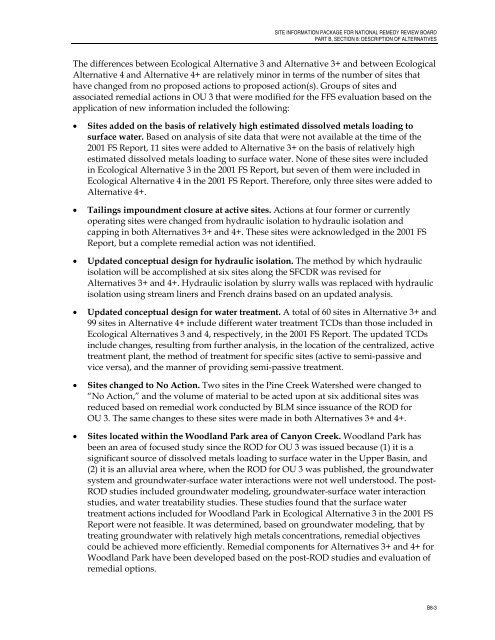Final Site Information Package for National Remedy Review Board ...
Final Site Information Package for National Remedy Review Board ...
Final Site Information Package for National Remedy Review Board ...
You also want an ePaper? Increase the reach of your titles
YUMPU automatically turns print PDFs into web optimized ePapers that Google loves.
SITE INFORMATION PACKAGE FOR NATIONAL REMEDY REVIEW BOARD<br />
PART B, SECTION 8: DESCRIPTION OF ALTERNATIVES<br />
The differences between Ecological Alternative 3 and Alternative 3+ and between Ecological<br />
Alternative 4 and Alternative 4+ are relatively minor in terms of the number of sites that<br />
have changed from no proposed actions to proposed action(s). Groups of sites and<br />
associated remedial actions in OU 3 that were modified <strong>for</strong> the FFS evaluation based on the<br />
application of new in<strong>for</strong>mation included the following:<br />
• <strong>Site</strong>s added on the basis of relatively high estimated dissolved metals loading to<br />
surface water. Based on analysis of site data that were not available at the time of the<br />
2001 FS Report, 11 sites were added to Alternative 3+ on the basis of relatively high<br />
estimated dissolved metals loading to surface water. None of these sites were included<br />
in Ecological Alternative 3 in the 2001 FS Report, but seven of them were included in<br />
Ecological Alternative 4 in the 2001 FS Report. There<strong>for</strong>e, only three sites were added to<br />
Alternative 4+.<br />
• Tailings impoundment closure at active sites. Actions at four <strong>for</strong>mer or currently<br />
operating sites were changed from hydraulic isolation to hydraulic isolation and<br />
capping in both Alternatives 3+ and 4+. These sites were acknowledged in the 2001 FS<br />
Report, but a complete remedial action was not identified.<br />
• Updated conceptual design <strong>for</strong> hydraulic isolation. The method by which hydraulic<br />
isolation will be accomplished at six sites along the SFCDR was revised <strong>for</strong><br />
Alternatives 3+ and 4+. Hydraulic isolation by slurry walls was replaced with hydraulic<br />
isolation using stream liners and French drains based on an updated analysis.<br />
• Updated conceptual design <strong>for</strong> water treatment. A total of 60 sites in Alternative 3+ and<br />
99 sites in Alternative 4+ include different water treatment TCDs than those included in<br />
Ecological Alternatives 3 and 4, respectively, in the 2001 FS Report. The updated TCDs<br />
include changes, resulting from further analysis, in the location of the centralized, active<br />
treatment plant, the method of treatment <strong>for</strong> specific sites (active to semi-passive and<br />
vice versa), and the manner of providing semi-passive treatment.<br />
• <strong>Site</strong>s changed to No Action. Two sites in the Pine Creek Watershed were changed to<br />
“No Action,” and the volume of material to be acted upon at six additional sites was<br />
reduced based on remedial work conducted by BLM since issuance of the ROD <strong>for</strong><br />
OU 3. The same changes to these sites were made in both Alternatives 3+ and 4+.<br />
• <strong>Site</strong>s located within the Woodland Park area of Canyon Creek. Woodland Park has<br />
been an area of focused study since the ROD <strong>for</strong> OU 3 was issued because (1) it is a<br />
significant source of dissolved metals loading to surface water in the Upper Basin, and<br />
(2) it is an alluvial area where, when the ROD <strong>for</strong> OU 3 was published, the groundwater<br />
system and groundwater-surface water interactions were not well understood. The post-<br />
ROD studies included groundwater modeling, groundwater-surface water interaction<br />
studies, and water treatability studies. These studies found that the surface water<br />
treatment actions included <strong>for</strong> Woodland Park in Ecological Alternative 3 in the 2001 FS<br />
Report were not feasible. It was determined, based on groundwater modeling, that by<br />
treating groundwater with relatively high metals concentrations, remedial objectives<br />
could be achieved more efficiently. Remedial components <strong>for</strong> Alternatives 3+ and 4+ <strong>for</strong><br />
Woodland Park have been developed based on the post-ROD studies and evaluation of<br />
remedial options.<br />
B8-3

















